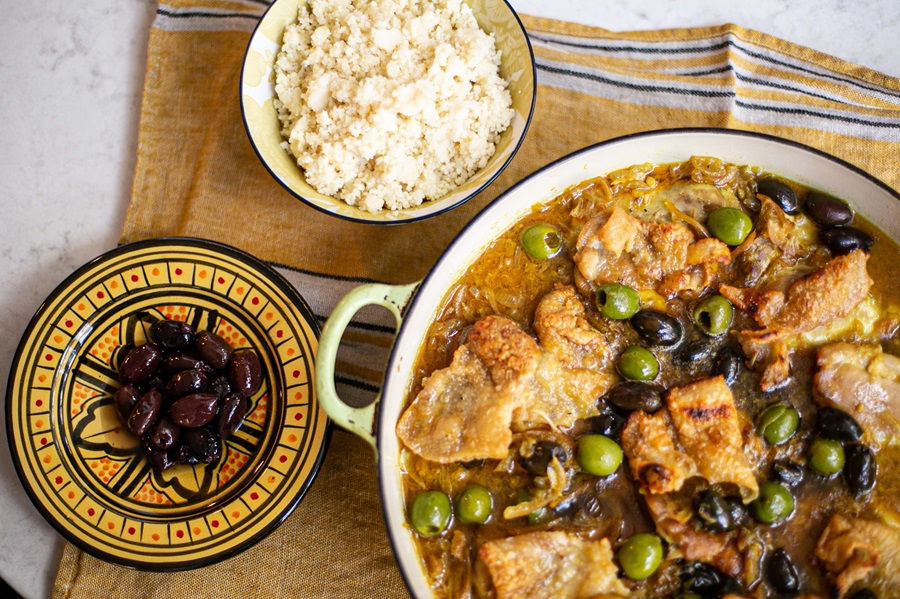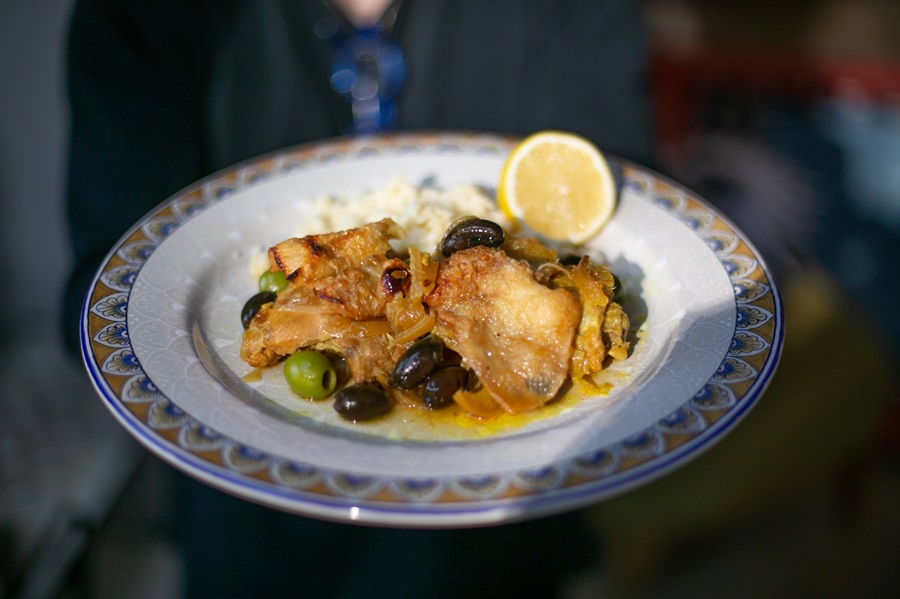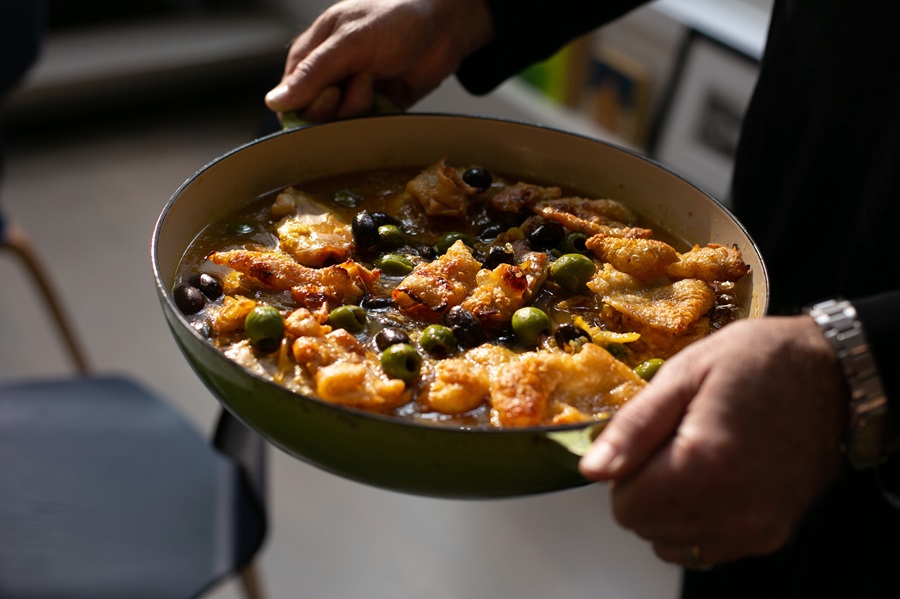It’s so cold that Eartha Kitt has stopped going outside entirely. She’s our cat, and she’s going soft in her old age. She stands and peers out the sidelight, but when I offer to open the door, she turns up her nose and climbs back into her bed. Truth be told, I’m not so keen on going out when it’s 20 degrees and the wind whipping through Lombard Hollow makes it feel like it’s 5. I am a New Orleans boy, after all.
On these wintry days, I want something deeply warming bubbling away on the stove. Even better if its aromas transport me somewhere warm. Morocco, maybe. Which would mean a tagine.

Tagine is traditional across the Maghreb — northwestern Africa — and particularly in Morocco. As with most traditional dishes, you’ll find innumerable variations, but essentially this is a slow braise of meat (most often chicken or lamb) with flavors supplied by saffron, turmeric, cumin, preserved lemon, olives, and often dried fruit.
The first time I had tagine, I was in France. On break from college classes in Paris, I had taken the train south to Marseilles to see Le Corbusier’s modernist architectural icon, the Cité Radieuse — idealistic and avant-garde social housing that was run down then but is now coveted by the well-to-do. Imagine that. The one-star hotel I stayed in was decidedly not a modernist icon, but I didn’t mind. Marseille was more cosmopolitan than any place I had ever been. I felt so daring ordering a tagine at a restaurant in a vast sidewalk market in a neighborhood of North African immigrants. Its flavors were as astonishing to me as were the other customers in their handsome robes.

I was in Morocco when I had tagine for the second time. And that is also where I had it for the third and fourth and maybe the 12th time. A few years ago, during a week in North Africa, Christopher and I were offered tagine of some sort at every meal. (OK, not for breakfast; that was usually soft cheese with honey, olives, flatbreads, and boiled eggs.)
“Not again,” I would say to myself. But some of those tagines were sublime. One that I will never forget was served to us in the desert near a settlement called Erg Chigaga. We sat on rugs around a fire. As far as we could see in every direction was undulating, unending sand. The moon was rising as the servers set large ceramic platters of a fragrant vegetable tagine and piles of flatbread before us.

Tagine is the name of both the dish and the clay pot in which it is traditionally cooked. The vessel has a shallow, circular base and a tall, conical lid designed to trap steam and circulate moisture during cooking, which is supposed to help tenderize the meat and enhance the flavors of the ingredients. I don’t have a tagine, so I just use a heavy Dutch oven.
My winter-in-Truro version is adapted from Paula Wolfert’s Couscous and Other Good Food From Morocco. It’s very forgiving: sometimes I add more vegetables — carrots if I have them on hand or cauliflower (Daniel Boulud has a wonderful recipe with cauliflower). I don’t include chopped dried fruit such as apricots, prunes, dates, or raisins, only because Christopher has an inexplicable aversion to fruit cooked with meats.

Fresh spices are important here. The combination I’ve used is a variation on the North African medley called ras el hanout, so if you happen to have a jar on hand, just use it instead of those listed here. Spice seekers around here know that Orleans Whole Food Market has a Frontier spices counter where you can buy just the amounts of each you want. And in Truro, we’re lucky to have Atlantic Spice, where even saffron, sumac, and preserved lemons can be found. But I recommend that you make the lemons yourself. The homemade version is easy and so good — though they’re a make-ahead thing; they need three weeks to brine. (See sidebar for the how-to.)
Traditionally, tagine is served directly from the pot, with diners using bread to scoop up the tagine. Here it invites communal gatherings, too. We circle around the Dutch oven with our bowls, forgetting the cold gusts of wind pounding at the door.
CHICKEN TAGINE
Makes 4 generous servings
1 chicken, cut in 8 to 10 pieces (or just chicken thighs)
Salt and freshly ground black pepper
5 cloves garlic, finely chopped
½ tsp. ground ginger
1 tsp. sweet paprika
½ tsp. ground cumin
½ tsp. turmeric
¼ tsp. saffron threads
2 Tbsp. extra virgin olive oil
3 medium onions, sliced thin
1 cinnamon stick
1 cup good quality pitted olives (kalamata, Castelvetrano, and/or cracked green)
1 large or 3 small preserved lemons
1 cup chicken stock
Juice of ½ lemon
1 Tbsp. chopped flat-leaf parsley and a sprinkle of sumac for garnish (optional)
- Rub chicken with ¾ teaspoon salt, cover, and refrigerate 3 to 4 hours. When ready to cook, stir together the garlic, ginger, paprika, cumin, turmeric, and pepper and set aside. Bloom the saffron: pulverize it, then soak in 2 tablespoons hot water for 5 minutes.
- Heat oil in a tagine or Dutch oven. Add chicken pieces and brown well on all sides, working in batches as needed. Remove chicken to a platter and pour off all but 2 tablespoons of the (I find chicken skin in a braised dish unappetizing, so I either discard it or run the finished dish under the broiler before serving to crisp it.) Add onions, spice mixture, and bloomed saffron to the pot and cook over medium-low heat about 15 minutes, until lightly browned. Add cinnamon stick.
- Settle the chicken pieces into the onions and scatter with olives. Quarter the preserved lemons (some recipes call for cutting the rinds in strips and discarding the pulp, but I use all of it). Scatter over chicken. Stir together stock and fresh lemon juice and pour mixture over chicken.
- Bring to a brisk simmer and then lower the heat and cover. Simmer gently about 30 minutes, until chicken is done. Scatter parsley on top and sprinkle with sumac if using. Serve with couscous and flatbread.
HOMEMADE PRESERVED LEMONS
Makes 1 quart. Allow 3 weeks for the brine to work its magic.

9 small lemons (thin-skinned organic lemons work best)
Kosher salt
1 tsp. black peppercorns
2 bay leaves
1 cinnamon stick
- Scrub 5 of the lemons (or as many as will fit tightly in a quart jar), reserving the remaining lemons. Slice each lemon vertically from the top to within ½ inch of the bottom, almost cutting them into quarters but leaving them attached at one end. Rub the salt over the cut surfaces and press the quarters back together. Sprinkle about a teaspoon of salt into the bottom of the jar along with half of the peppercorns and then push half of the cut lemons in. It may be necessary to break apart some of the lemons to fit them in tightly. Sprinkle a teaspoon of salt over the lemons when the jar is half full. Add the cinnamon stick, bay leaves, remaining peppercorns and the rest of the salted lemons.
- Press the lemons down to release their juices, then squeeze the juice from the remaining whole lemons into the jar until the juice covers everything.
- Close the jar and let the lemons sit at room temperature in a cool, dark place. Shake the jar every day or so for about 3 weeks, or until the rinds are tender to the bite. Store the jar in the refrigerator where the lemons will last indefinitely.
- To use, remove a piece of lemon and rinse lightly. (Add more fresh lemons to the brine as you use them up.) Both the rind and the pulp may be used.



